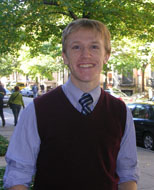Exploring the Facebook frontier
At UNI, testing theories of social connectivity

During his freshman year at BU, Soren Michael Hessler (UNI’08) decided to test the theory that all people are connected through no more than five other people — six degrees of separation — via the Facebook, which was then a new communications medium for college students. He selected 10 people at random, each at a different college or university, and sent a message to all his friends asking them to pass it on to one other person. The idea, he says, was to find out how many connections it took to reach each target.
Hessler successfully reached only one target — a freshman at George Washington University — but the resulting paper, "An Experimental Study of the Small World Problem on thefacebook.com,” won the University Professors Program’s Dean Edmonds Prize for the best seminar research paper. BU Today talked with Hessler about the study, his results, and what he learned about the social-networking phenomenon that is Facebook.
Hessler’s study can be read at the University Professors Program offices at 745 Commonwealth Ave.
BU Today: What made you want to conduct this study?
Hessler: All the UNI freshman are required to write an interdisciplinary research paper, and instead of doing normal book research, I opted to do something out of the box. The category was connectivity — it was based on a lecture given by [UNI and CAS physics professor] Eugene Stanley, and his discussion involved the degrees of separation theory. I thought it would be fantastic to see if this played out on the Facebook.
How did you do the research?
I wanted to see how many connections there were between person X and person Y, myself being person X, and person Y being chosen at random from across the world. There were certain schools I was interested in using — Oxford was one and I wanted to use Ohio State University because I’m from Ohio. As far as trying to find targets beyond that point, my chances were about one in 10, so then I just looked at people’s pictures to see if they looked like someone who’d do something crazy on Facebook.
Then I would send a message to all of my friends with a short bio of person Y, and ask them to send it to one of their most likely candidates to know the target, based on things like year of graduation and where they went to college. What would happen, in theory, is that message would be pushed by my friend to another friend.
The catch was that you could only forward it to one of your Facebook friends. It couldn’t be to everyone on Facebook.
Did it work?
I attempted to reach 120 to 130 targets, and reached about 10. Out of the 260 messages that I sent out, only one worked its way back to me. What happened was that I hadn’t started out with enough messages to scientifically prove it. I would have needed to send out 100 times the messages that I did. Then again, it was only supposed to be a 15-page research paper.
But what started out as a study in connectivity also became a sociological experiment in people’s interest and behavior. The Facebook is a unique online community — it’s a student community, so it’s not something that fits the schedule and structure of a “normal” life. I thought it was interesting that people check it out so frequently and found that people who check it frequently were most likely to participate.
The Facebook had been at BU for less than a year when you started your study. What differences would you expect to find now that it’s such an important part of college life?
I think that at the time I was doing it, the Facebook in the Northeast was nearly as popular as it is now, but in other parts of the country, it wasn’t. It hadn’t become a huge phenomenon until a full year after I was doing my research. By sheer numbers, I think that would have helped in making my connections.
Now I check the Facebook probably once a day. It’s just become another form of communication, and using it depends on how you choose to communicate with your social circle.